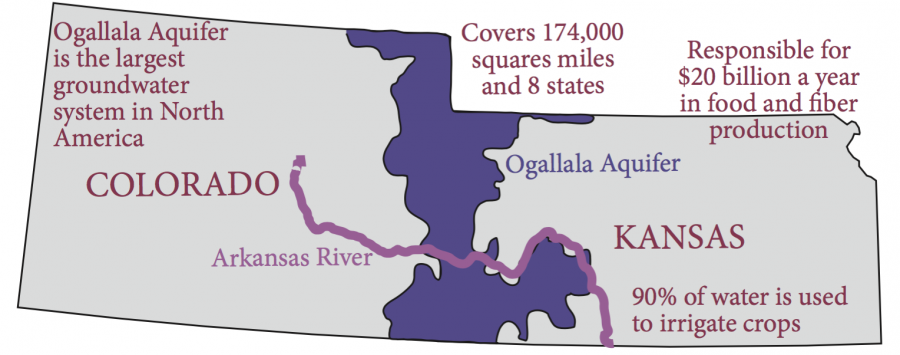Depletion and Repletion
Science teacher weighs in on water problem in the United States
It makes up 70 percent of our planet. It’s clear. Life is contingent upon its existence.
Water.
It seems like our planet has water everywhere — rivers, lakes and oceans — so why are we facing a shortage?
The issue is freshwater, which only makes up about 3 percent of all the water on the earth, and drinkable water is just under 1 percent.
Freshwater is stored in ice and glaciers as well as in rivers, streams and groundwater.
Rivers are used for our drinking water, and streams are usually grossly contaminated. Ice and glaciers are melting at an alarming rate into saltwater oceans, which eliminates it from freshwater supplies.
Groundwater is largely used for irrigation for farms and cities, and this, too, is being depleted rapidly.
Science teacher Andrew Hulse said irrigation and farming are the top reasons water is being used.
“For the past 20 or so years we’ve been experiencing a drought,” Hulse said. “Water hasn’t been as available. Coupled with our increasing population and our increased need for food, we basically have a bank account that’s going down with the need for credit going up.”
Because of the growing population, decreased food production isn’t much of a solution.
“We need agriculture to grow food,” Hulse said. “Obviously, that’s going to be a huge need for our survival, but it’s also the largest pull from our local water systems.”
United States agriculture is the largest in the world and is mass produced in most cases.
“It’s not normal for our planet to grow thousands and thousands of acres of the same product,” Hulse said. “In doing so, it requires us to use an additional amount of water and chemicals in order to facilitate that growth. We need to find a way to carry out agriculture in way that doesn’t stress our resources.”
Especially in the Midwest, agriculture is one of the biggest industries, but with water being increasingly unavailable, lifestyles are going to change.
“Without water, the most arable land in the world — the Midwest — isn’t going to be usable, which is going to greatly affect the food industry,” Hulse said. “If you go to Western Kansas, they don’t do cropland anymore. It’s just grassland for grazing cattle because it couldn’t sustain crops.”
According to cornelllaw.com, there has been an ongoing Supreme Court case between Kansas and Colorado over the Arkansas River for more than 100 years.
“Kansas and Colorado have been continually suing each other over the Ogallala Aquifer since the early 1900s,” Hulse said. “Running from the mountains in Colorado to Kansas is the Arkansas River. That’s where the Ogallala Aquifer gets replenished from our state. Colorado has been diverting the Arkansas River in order to irrigate its farmland and cities in Eastern Colorado. That reduces the volume [of water] that makes it to Kansas. So we sued them, and the Supreme Court said Colorado had to pay us money each year, but we don’t want money — we need water.”
To use less water, Hulse said it’s important to use water in better, more effective ways.
“We waste water with at-home use and personal use, like long showers or running the faucet while brushing our teeth,” Hulse said. “We have to balance those depletion and recharge rates. We have to educate people on how to preserve those arable lands.”
As for the government, Hulse said regulation and fines are ways to preserve water.
“The government could regulate the percentage of water each area takes,” Hulse said. “That would help the situation.”

Charlotte Rooney is a senior and the opinion editor for “The Tiger Print.” She loves writing opinions about current events and writing news stories...




